

Autoimmune conditions are those where the body’s immune system produces antibodies that attack specific normal cells causing pathological situations and result in certain signs and symptoms being experienced by affected individuals.
In the case of autoimmune blood disorders, antibodies that are produced by the immune system attack specific cells in the bloodstream. These include the white blood cells, red blood cells, and the platelet cells.
Contents
There are two main different types of autoimmune blood disorders: those where there is a direct injury to the blood cells (which are regarded the “true” blood disorders), and those that are secondary as a result of changes to the blood components caused by other autoimmune conditions.
The first group includes the following autoimmune blood disorders where antibodies directly attack blood cells:
The second group of secondary autoimmune blood disorders includes a condition such as anti phospholipid syndrome (APLS) and lupus. Patients affected with antiphospholipid syndrome may experience increased clotting time of their blood which increases the risk of developing complications such as a heart attack or a stroke. Patients diagnosed with lupus may end up with a combination of conditions such as neutropenia (decreased white cell count), anemia, and thrombocytopenia.
Women seem to be at a higher risk for developing autoimmune conditions in general and since there seems to be an association between autoimmune diseases and autoimmune blood disorders, it can be said that autoimmune blood disorders would then follow the same pattern and have an increased chance of developing in these women, too. With that being said, it’s important to take note that the two “real” autoimmune blood conditions, autoimmune hemolytic anemia and immune thrombocytopenic purpura, may develop on their own without the affected individual being diagnosed with any other autoimmune conditions.
Having a family history of autoimmune blood disorders and autoimmune conditions would also increase the chances of an individual developing any of these illnesses.
Unfortunately, there is no cure for autoimmune blood disorders because the body’s immune system continues to produce antibodies that result in damage to the blood cells. The conditions can be managed effectively enough though with medications which suppress the immune system so that less of the pathological antibodies are produced. These include initially using steroids but if they are not effective then doctors will use a medication such as rituximab.2
If the immunosuppressant drugs don’t work to control the conditions then a combination of protein electrophoresis, where as many of the circulating antibodies are removed from the bloodstream, and administration of intravenous immunoglobulin, to help fight off the abnormal antibodies, is attempted.
If this therapy also fails, then the patient and their doctor may consider stem cell/bone marrow transplantation which involves completely clearing the patient’s immune system through radiation therapy or chemotherapy and then administering donor stem cells to reboot their immune system. You can find best doctors and hospitals at xpertdox.
Reference
1. Olsson M, Hagnerud S, Hedelius DUR, et al. Hematologic Diseases: Autoimmune Hemolytic Anemia and Immune Thrombocytopenic Purpura. In: Madame Curie Bioscience Database [Internet]. Austin (TX): Landes Bioscience; 2000-2013. Available from: https://www.ncbi.nlm.nih.gov/books/NBK6032/
2.Park SH. Diagnosis and treatment of autoimmune hemolytic anemia: classic approach and recent advances. Blood research. 2016;51(2):69-71. doi:10.5045/br.2016.51.2.69.
How to Relieve Eye Strain: Do you find yourself blinking throughout the day? Do your…
Pagalmovie’s extensive collection of Bollywood, Hollywood, and regional films has made it associated with free…
For an excellent Google Ads campaign, it is essential to understand the PPC auction process.…
As of 2024, the number of online shoppers worldwide reached approximately 2.71 billion, accounting for…
For a retailer to provide their customers with the products they want, when they want…
Located at the base of the Ten mile Range of the Rocky Mountains, Breckenridge is…